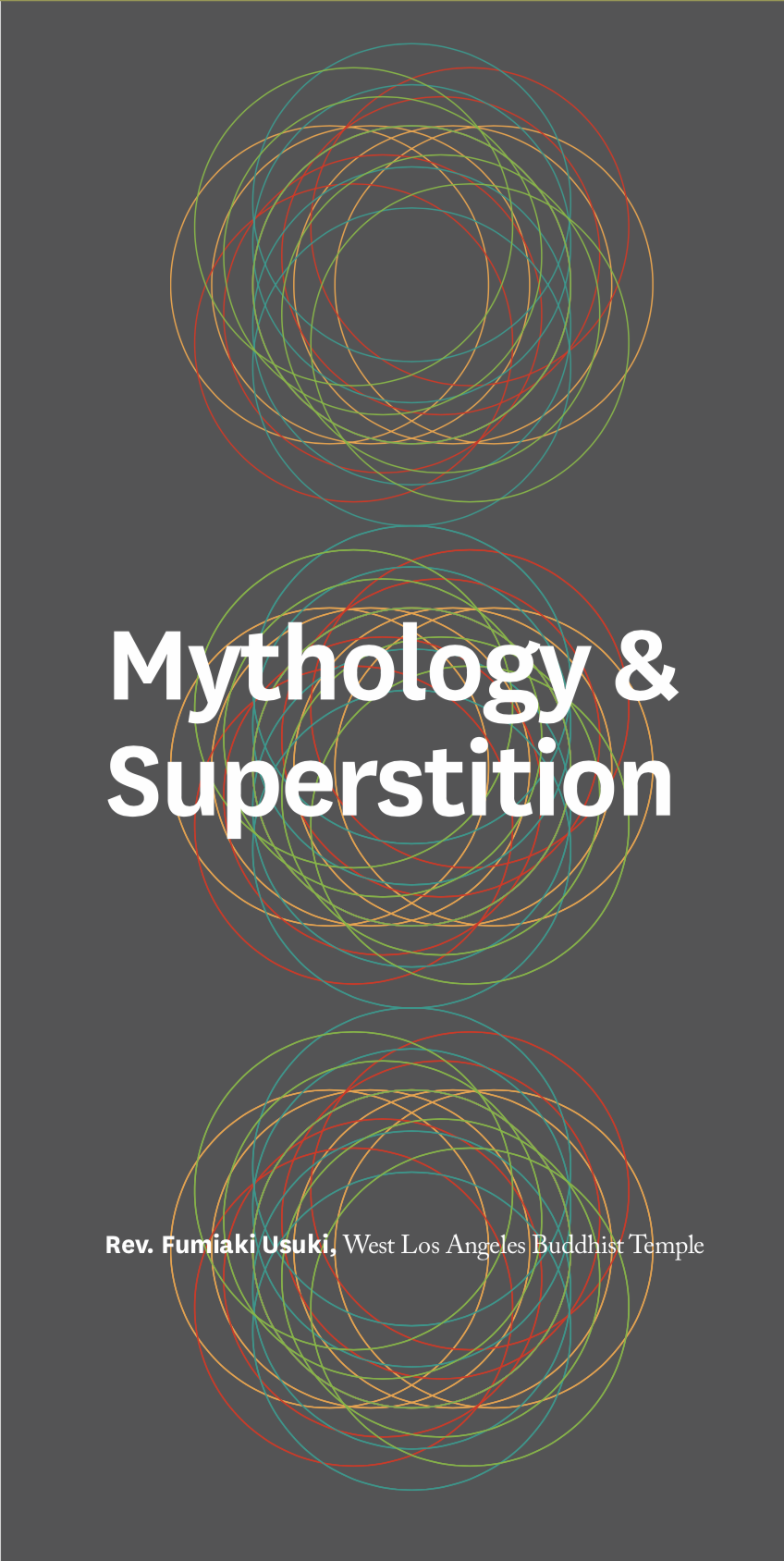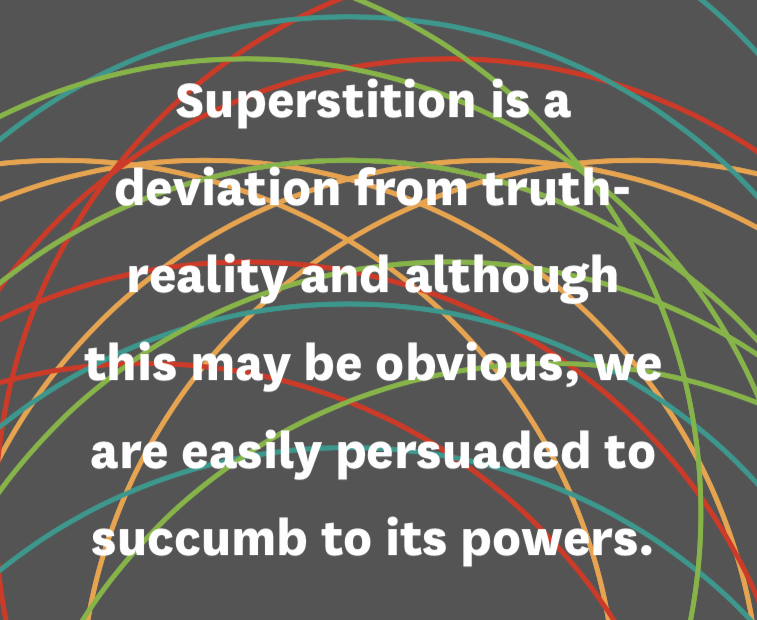Mythology & Superstition
We rely upon Tathagata Amida with our whole heart for Enlightenment in the life to come, abstaining from all sundry practices and teachings, and giving up the trust in our powerless self…
RYOGEMON – Rennyo Shonin
 Myths, superstition, spirit, luck, fate and such beliefs are as old as mankind and existed in all early religions, societies and cultures. Infused permanently into our thoughts and lives, they are an intriguing and confusing part of culture. We may believe that we live in a highly educated and sophisticated society with tremendous scientific, medical and technological accomplishments, yet many human beings still remain fundamentally reliant on emotion-based ideas and teachings. Despite counting on logic and common sense to live a well-calculated and painless life, people fall apart at the slightest thought of separation caused by the difficulties of life or death. During such encounters, some grasp at immediate salvation in one form or another. They yearn for relief in a better afterlife, while embracing myths and superstitions as a reasonable approach to life. It is easy to be comforted by others when they assure us that everything will be all right and that time will heal all wounds. Some pray to certain buddhas and over incense and food as forms of supplication. Sakyamuni Buddha clearly dismissed and warned against such practices.
Myths, superstition, spirit, luck, fate and such beliefs are as old as mankind and existed in all early religions, societies and cultures. Infused permanently into our thoughts and lives, they are an intriguing and confusing part of culture. We may believe that we live in a highly educated and sophisticated society with tremendous scientific, medical and technological accomplishments, yet many human beings still remain fundamentally reliant on emotion-based ideas and teachings. Despite counting on logic and common sense to live a well-calculated and painless life, people fall apart at the slightest thought of separation caused by the difficulties of life or death. During such encounters, some grasp at immediate salvation in one form or another. They yearn for relief in a better afterlife, while embracing myths and superstitions as a reasonable approach to life. It is easy to be comforted by others when they assure us that everything will be all right and that time will heal all wounds. Some pray to certain buddhas and over incense and food as forms of supplication. Sakyamuni Buddha clearly dismissed and warned against such practices.
This man who was seen daily begging in the Indian marketplaces is now represented in golden images on the altars of pagodas throughout the Far East. There he sits enveloped in clouds of incense amid a buzz of prayers. All this in spite of his having forbidden it before his death. His disciples, believing him to have supernatural intelligence and moral power, have turned him into a god. Even those who are not Buddhists admit that his great figure is the one most human and most worthy of universal admiration ever produced by India.
A. FOUCHER – The Life of the Buddha
Shinran Shonin, who relied faithfully on Sakyamuni Buddha’s teachings, also encouraged his followers to abandon such unreliable ideas. The opening passage, attributed to Rennyo Shonin, is a clear rule of conduct for Jodo Shinshu followers to heed the words of Shinran and Sakyamuni Buddha. However, superstitions have played a major role in folk religions and commonly influenced people of the past who lacked proper Buddhist education in village societies. Such beliefs have been passed on to us in a detrimental way. Whether in jest, for fun, or due to ignorant or hidden personal beliefs, superstitions can present a danger to the faithful and can undermine warnings issued by our teachers. Most religions consider superstition to be antithetical, for it indicates a lack of trust in the teaching. Superstition is a deviation from truth-reality, and although this may be obvious, we are easily persuaded to succumb to its powers.
 There are many instances of Buddhism today that embrace and suggest myths, superstition, prayer and worship. Buddhism is known for its imaginative and beautiful parables and legends, created by people of India, China, Southeast Asia, Japan, and more recently, Tibet. Many of these parables represent an early form of transmission, for the tradition was passed on only orally for some four centuries after the Buddha’s lifetime. These legends and myths purported to be told by Sakyamuni include many supernatural stories.
There are many instances of Buddhism today that embrace and suggest myths, superstition, prayer and worship. Buddhism is known for its imaginative and beautiful parables and legends, created by people of India, China, Southeast Asia, Japan, and more recently, Tibet. Many of these parables represent an early form of transmission, for the tradition was passed on only orally for some four centuries after the Buddha’s lifetime. These legends and myths purported to be told by Sakyamuni include many supernatural stories.
In the Jataka Tales, Sakyamuni was portrayed as having many previous lives as a bodhisattva, taking form as animals, gods and other beings. Although he specifically directed his disciples to follow his path to Enlightenment and to treat him as an ordinary person, because he was able to attain the highest wisdom and compassion beyond normal understanding, people could not treat him otherwise. Great tribute was paid to him, and it continues to this day.
The Jatakas, or Birth-stories, form one of the sacred books of the Buddhists and relate to the adventures of the Buddha in his former existences, the best character in any story being identified with the Master. These legends were continually introduced into the religious discourses of the Buddhist teachers to illustrate the doctrines of their faith or to magnify the glory and sanctity of the Buddha, somewhat as medieval preachers in Europe used to enliven their sermons by introducing fables and popular tales to rouse the flagging interests of their hearers.
ELLEN C. BABBITT – The Jataka Tales of India
Sakyamuni was bestowed a god-like status, contrary to the reality that all people could be like him and attain awakening in this life. Thus, people soon separated the potential of individual attainment of bodhi from the path of worship and devotion to Sakyamuni Buddha. Since we know very little of his actual life and because no written words from his era can be found, most sutras written long after his death by monks and scholarly priests took liberties to create ideals based on mythical bodhisattvas, buddha lands and other new images. These were part of a glorified and metaphorical new Mahayana Buddhism. Thousands and thousands of such writings remain today to portray the greatness of the Buddha, his image, and the various ways we might understand a life of enlightenment.
However, all Buddhists have accepted, whether mythical, legendary or plausible, certain elements of Sakyamuni’s life. These are Gautama’s birth, studies, curiosity, leaving home, ascetic practices, attaining bodhi, 45 years of teaching, his death, and final Nirvana. Nonetheless, there are scores of schools of Buddhism, and each has a different approach to practice and to realization of enlightenment. So what are we to understand and how are we to engage meaningfully with so many fantastic stories, ideas, and contradictions?
Rev. Masao Kodani suggests the following on the myth of the most famous story, the Hanamatsuri or Flower Festival which celebrates the Buddha’s birth:
To a child, the legend is a fascinating world of images; to the young cynic, it is a silly and meaningless myth; to the psychologist, it is perhaps pregnant with meaning; to the religious, it is perhaps true as an act of faith. It may be one, all, or none of these things to any given person. Yet, Hanamatsuri is one of the most powerful stories in Buddhism, and the one most vividly remembered. Its power cannot be felt in the world of reason, logic, or history. Its meaning and ability to move us deeply is of another realm, not magic, not supernatural, but nevertheless not of our everyday world. Hidden in this story is the outline of enlightenment. Hidden in this story is Namu Amida Butsu.
Rev. Fumiaki Usuki, West Los Angeles Buddhist Temple

